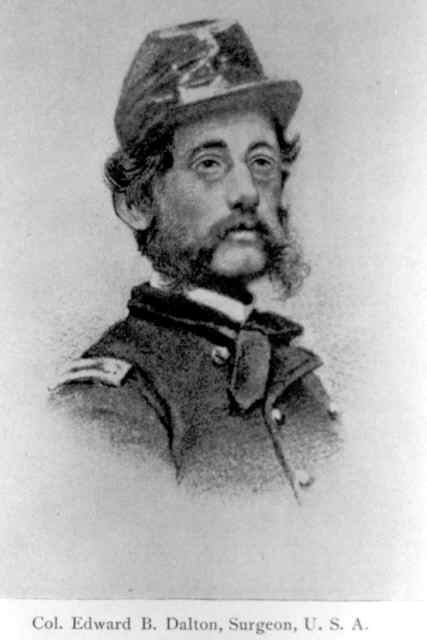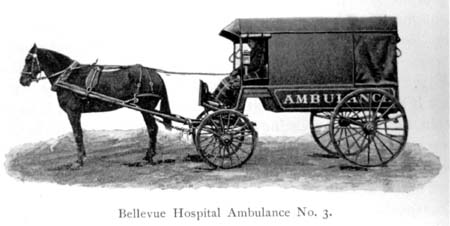From Dr. Edwin Knights, 1945
 During the Civil War, Dr. Edward B. Dalton, a surgeon in the Army of the Potomac, was assigned the task of establishing field hospitals behind the battle lines. The wounded, most with gunshot wounds and associated fractures, were removed from the front using stretchers, horse-drawn carts and two-wheeled wagons, frequently sustaining further injury in the process. Recognizing that this process needed vast improvement to expedite removal and decrease secondary injuries, Dr. Dalton developed the military ambulance. Dalton’s ambulance had a roof to shelter the wounded and a suspension system to absorb the shocks of rapid movement over irregular ground. A red cross emblazoned on the side identified the wagon as a conveyance of the wounded. The Dalton ambulance became the standard throughout the Army, and was credited for saving hundreds, if not thousands of lives.
During the Civil War, Dr. Edward B. Dalton, a surgeon in the Army of the Potomac, was assigned the task of establishing field hospitals behind the battle lines. The wounded, most with gunshot wounds and associated fractures, were removed from the front using stretchers, horse-drawn carts and two-wheeled wagons, frequently sustaining further injury in the process. Recognizing that this process needed vast improvement to expedite removal and decrease secondary injuries, Dr. Dalton developed the military ambulance. Dalton’s ambulance had a roof to shelter the wounded and a suspension system to absorb the shocks of rapid movement over irregular ground. A red cross emblazoned on the side identified the wagon as a conveyance of the wounded. The Dalton ambulance became the standard throughout the Army, and was credited for saving hundreds, if not thousands of lives.
Following the war, Dr. Dalton was engaged by New York City’s Department of Charities and Corrections (who administered the ambulance service, addressed the needs of both the poor and criminal elements) to develop a civilian version of the ambulance corps employed by the Army. On June 30, 1869, the Medical Board of Bellevue held the first examination for ambulance surgeons and the nation’s first municipal ambulance service was inaugurated.
 Ambulances were staffed by a driver and an “ambulance surgeon", in fact, an intern fresh out of two years of medical school. Ambulance surgeons would spend two months riding the ambulance. When not on ambulance duty, they were assigned shifts in the emergency ward.
Ambulances were staffed by a driver and an “ambulance surgeon", in fact, an intern fresh out of two years of medical school. Ambulance surgeons would spend two months riding the ambulance. When not on ambulance duty, they were assigned shifts in the emergency ward.
These original two horse-drawn vehicles were designed and manufactured by the Abbot-Downing Company, and were placed into service at Bellevue Hospital in lower Manhattan. The only warning device was a bell operated by a foot pedal on the floorboard of the ambulance. A single horse pulled the ambulance, as it raced along Manhattan’s cobblestone streets. A box underneath the driver's seat contained "a quart flask of brandy, two tourniquets, a half-dozen bandages, a half-dozen small sponges, some splint material, pieces of old blankets for padding, strips of various lengths with buckles, and a two-ounce vial of persulphate of iron."
Bellevue’s ambulances accommodated two patients lying down or eight sitting. Painted black and dark red, these wagons had the word "AMBULANCE" emblazoned in gold leaf on both sides and the rear, as well as on an arched roof sign in front. The vehicles also were fitted with lamps on the sides and a reflector affixed to the roof. Inside, sling straps and a surgeon’s lantern hung from the ceiling. Other accouterments included a rolling bed which slid in and out on an iron track, several auxiliary stretchers on rollers, pillows, blankets, medical and surgical supplies, splints, antiseptic solutions, tourniquets, bandages, sponges, blankets for padding, a straitjacket and a stomach pump.
The medicine chest contained emetics for poisoning cases, antidotes of various types, anesthetics, Vaseline, brandy, morphine, ergot, amyl nitrite, and assorted other drugs that were specially marked and fitted into a tray to avoid breakage. In addition, the ambulance surgeon carried a black leather satchel containing hypodermic syringes, tracheotomy tubes, a Nealaton's probe, catheters and dressings for minor wounds.
New York City's ambulance system employed telegraphic communications between the police department and hospitals, and through signal boxes dispersed throughout the city and connected to fire departments. Most calls came through the police, originating from an officer at the site to police headquarters, and were then forwarded to the nearest hospital.
When the alarm originated from a signal box, it usually sounded in all hospitals maintaining an ambulance service. When hospitals received an alarm, a bell rang simultaneously for the surgeon, the driver and the gatekeeper. The speed with which the ambulance driver responded to the call was enhanced by a clip-harness, which allowed a horse to be harnessed within seconds. Its inventor, C.L. Berry of Boston, greatly facilitated the special manner for hitching horses to the ambulance. In his system, the harness, saddle and collar were suspended from the ceiling and dropped into place at the sound of the alarm.
Depending on the seriousness of the call, the ambulance either brought the injured person to the accident ward or took the patient home, before returning to the hospital to await another call. In either case, the ambulance surgeon maintained a log noting the time of call, start, arrival, departure and any details that "a coroner's jury might possibly require".